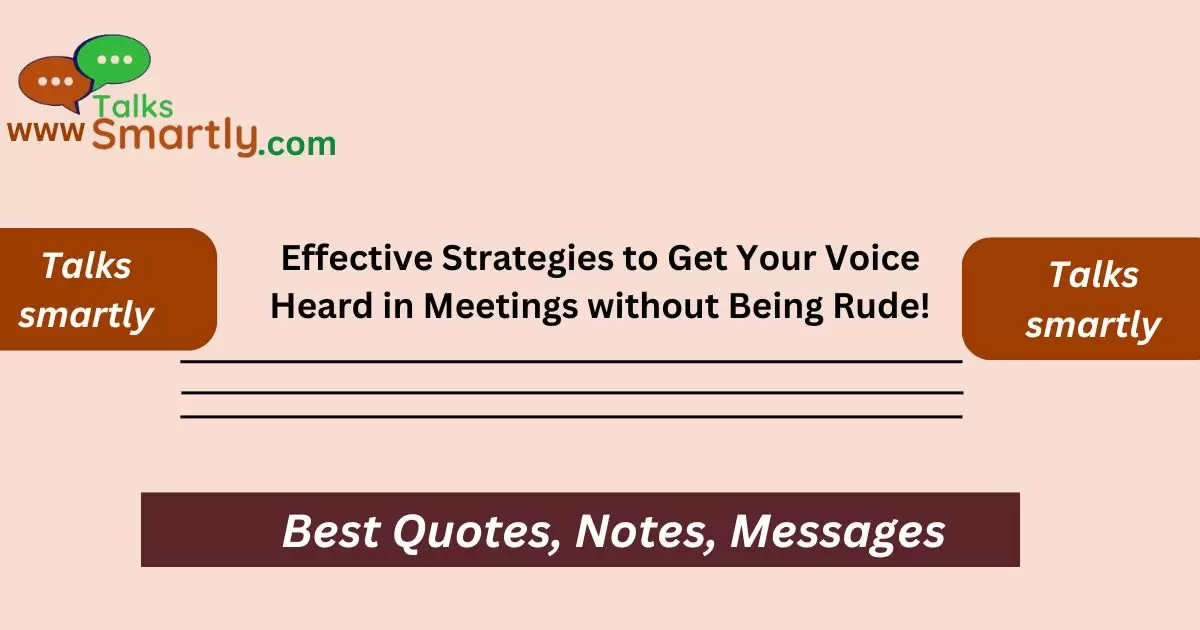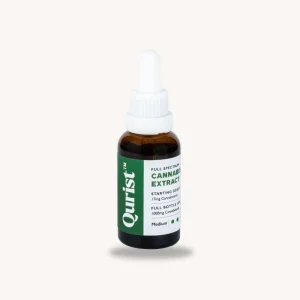Introduction
Essential techniques to communicate confidently and courteously in meetings. Master the art of making your voice heard without coming across as impolite!
Are you looking to make yourself heard in meetings without seeming rude? Mastering this skill can significantly enhance your professional impact. In our guide, we explore effective strategies to help you speak up with confidence and assertiveness.
Practice these strategies to transform how you contribute in meetings. Embrace the opportunity to share your insights without hesitation. Start applying these tips today and notice the difference it makes in your interactions.
This article aims to equip you with practical techniques for enhancing your presence in meetings. You’ll discover proven methods to express your ideas assertively and respectfully. Whether you’re new to the workplace or seeking to refine your communication style, these strategies are tailored to help you navigate professional settings with confidence.
Why Does Your Voice Matter in Meetings?
Your voice matters in meetings for several reasons. Firstly, sharing your ideas and perspectives can lead to innovative solutions and better decision-making within your team or organization. Secondly, speaking up in meetings can enhance your professional reputation, demonstrating your expertise and commitment.
Lastly, being an active participant helps build confidence and leadership skills, positioning you as a valuable team member. Ensuring your voice is heard allows you to contribute effectively and be recognized for your efforts.
Make Your Voice Count: Tips to Be Heard
Prepare in Advance
Preparation is key to making your voice count in meetings. Before the meeting, review the agenda and gather any necessary information. Preparing thoughtful questions or comments will ensure you’re ready to contribute meaningfully. By being well-prepared, you can confidently share your insights and ideas.
Choose the Right Moment
Timing is crucial when trying to make your voice heard. Avoid interrupting others or speaking out of turn. Instead, wait for a natural pause or when the meeting leader invites comments. This shows respect for others while giving you the opportunity to share your thoughts.
Speak Clearly and Confidently

When you do speak, ensure your voice is clear and confident. Avoid mumbling or speaking too softly. Maintain good posture and eye contact with your audience to convey confidence. Practice speaking assertively without being aggressive to ensure your message is well-received.
Be Concise and to the Point
In meetings, time is often limited, so it’s important to be concise and to the point. Avoid rambling or going off on tangents. Focus on your main message and support it with clear and relevant points. Being succinct makes your contributions more impactful and easier for others to follow.
Use Positive Body Language
Positive body language can reinforce your verbal communication. Sit up straight, make eye contact, and use hand gestures to emphasize key points. Avoid crossing your arms or displaying closed-off body language, as this can be perceived as defensive or uninterested.
Standing Out in Virtual Meetings
Ensure Technical Readiness
Technical issues can derail your contributions in virtual meetings. Before the meeting, test your equipment, including your microphone and camera. Ensure you have a stable internet connection to avoid disruptions. Being technically prepared allows you to focus on the content of the meeting.
Use Visual Aids
In virtual meetings, visual aids can help you stand out. Share slides, documents, or other visual materials to support your points. Visual aids can make your presentation more engaging and help illustrate complex ideas clearly.
Engage Actively
Active engagement is crucial in virtual meetings. Use the chat function to share quick comments or questions without interrupting the speaker. When appropriate, use the raise hand feature to indicate you want to speak. Engaging actively shows you’re attentive and interested in the discussion.
Mind Your Background
Your background in a virtual meeting can affect how you’re perceived. Ensure your background is professional and free from distractions. A cluttered or inappropriate background can divert attention away from your message. Consider using a virtual background if necessary.
Essential Tips and Examples for Addressing ‘Why Remote Work Is Your Choice’
Empower Others: Help Your Colleagues Be Heard
Encourage Participation
Encourage participation from quieter colleagues by inviting them to share their thoughts. Phrases like “I’d love to hear what Jane thinks about this” can create opportunities for others to contribute. This fosters a more inclusive and collaborative environment.
Acknowledge Contributions
Acknowledge and build on others’ contributions. This not only shows respect but also creates a more dynamic and engaging discussion. Phrases like “I agree with John’s point and would like to add…” can seamlessly integrate your ideas with those of your colleagues.
Foster a Supportive Environment

Create a supportive environment where everyone feels comfortable speaking up. This includes being respectful and patient when others are speaking. Avoid dominating the conversation and be mindful of giving others the chance to contribute.
Provide Constructive Feedback
When giving feedback, be constructive and positive. Focus on the ideas rather than the individual. Constructive feedback helps improve the quality of discussions and encourages continuous improvement.
Key Things to Remember
Respect Differences
Respect the different communication styles and perspectives of your colleagues. Understand that everyone has unique ways of expressing themselves and contribute accordingly. This respect fosters a more harmonious and productive meeting environment.
Practice Active Listening
Active listening is essential for effective communication. Pay full attention to the speaker, avoid distractions, and show that you’re engaged through nodding or verbal affirmations. Active listening ensures you understand others’ points and respond appropriately.
Be Open to Feedback
Be open to feedback on your own communication style. Ask for constructive criticism from colleagues or supervisors to identify areas for improvement. Continuous improvement in how you communicate will enhance your effectiveness in meetings.
Reflect and Improve
After each meeting, reflect on what went well and what could be improved. Consider how effectively you communicated and how well you listened to others. Use this reflection to make continuous improvements in your meeting participation.
Assertiveness Techniques for Productive Contributions
Assertiveness is key to ensuring your ideas are heard and respected in meetings. Here are some effective techniques:
- Using “I” Statements: Begin your contributions with phrases like “I believe,” or “I suggest,” to assert ownership of your ideas.
- Active Listening and Acknowledgment: Demonstrate engagement by actively listening to others and acknowledging their points before presenting your own.
- Clear and Concise Communication: Structure your thoughts clearly to convey your message succinctly, avoiding ambiguity.
- Using Data and Examples: Support your points with relevant data or examples to strengthen your argument.
Building Confidence in Your Communication Style
Confidence plays a significant role in how your ideas are perceived. Consider these strategies:
- Preparation: Anticipate meeting topics and prepare your points in advance to boost your confidence.
- Body Language: Maintain eye contact, use open gestures, and project a confident posture to reinforce your message.
- Practice Assertive Language: Use assertive phrases such as “I feel strongly that…” or “From my perspective…” to convey confidence in your ideas.
- Seek Feedback: Request feedback from colleagues or mentors to improve your communication style and confidence.
Handling Interruptions and Disagreements Diplomatically

Navigating interruptions and disagreements tactfully is essential for maintaining respectful dialogue. Here’s how to manage these situations:
- Active Listening and Pause: Pause briefly after someone interrupts to acknowledge their point and then assertively return to your contribution.
- Redirecting Attention: Politely redirect the conversation back to your point by saying, “I’d like to add to that…”
- Addressing Disagreements: Acknowledge differing opinions respectfully, using phrases like “I understand your perspective; however, I believe…”
- Inviting Others to Speak: Encourage participation from quieter members by asking for their input, fostering a balanced discussion.
Cultivating a Positive Meeting Environment
Creating a positive atmosphere promotes open communication and enhances productivity. Consider these tips:
- Respect and Courtesy: Show respect to all participants by listening actively and refraining from interrupting.
- Encouraging Diverse Perspectives: Value diverse viewpoints and encourage contributions from all team members.Setting Ground Rules: Establish meeting norms that promote respectful communication, such as allowing each person to finish their thoughts before responding.
- Summarizing Key Points: Summarize key discussions periodically to ensure clarity and alignment among participants.
Seeking Opportunities to Contribute
1. Prepare Thoughtfully
Before the meeting, review the agenda and prepare your points succinctly. Highlight areas where your expertise can add value.
Example: If the agenda includes discussing marketing strategies, prepare insights backed by recent data to support your suggestions.
2. Timing Is Key
Choose the right moment to speak up. Avoid interrupting others and look for natural pauses or discussion transitions.
Example: Instead of interjecting abruptly, wait for the current speaker to finish their point before raising your hand or making eye contact to indicate your readiness to contribute.
3. Use Assertive Language
Employ clear and assertive language to convey your ideas confidently without sounding aggressive or dismissive of others’ opinions.
Example: Instead of saying, “That idea won’t work,” try “I see potential in that idea; however, we might enhance its effectiveness by considering…”
4. Active Listening

Demonstrate active listening by acknowledging others’ contributions and building upon them to foster a collaborative atmosphere.
Example: Respond to a colleague’s suggestion with, “I appreciate that point. Adding to that, we could also explore…”
Handling Disagreements with Tact
1. Respectful Dissent
When disagreeing, express your viewpoint respectfully and offer constructive alternatives rather than outright criticism.
Example: Instead of saying, “I don’t agree with that,” try “I see it differently. Have we considered…”
2. Seek Common Ground
Look for areas of agreement to bridge differences and steer the discussion towards mutually beneficial solutions.
Example: If there’s disagreement on project timelines, acknowledge shared goals and propose a compromise that meets both deadlines and quality standards.
3. Encourage Dialogue
Encourage open dialogue by inviting others to share their perspectives, creating a more inclusive discussion environment.
Example: Prompt colleagues with, “I’d like to hear your thoughts on this approach. How do you see it aligning with our objectives?”
Conclusion
Getting your voice heard in meetings is crucial for your professional development and the success of your team. By preparing in advance, choosing the right moment, speaking clearly and confidently, and being concise, you can effectively make your contributions count.
In virtual meetings, ensuring technical readiness, using visual aids, engaging actively, and minding your background can help you stand out.
Additionally, empowering others by encouraging participation, acknowledging contributions, fostering a supportive environment, and providing constructive feedback creates a more inclusive and productive meeting space.












